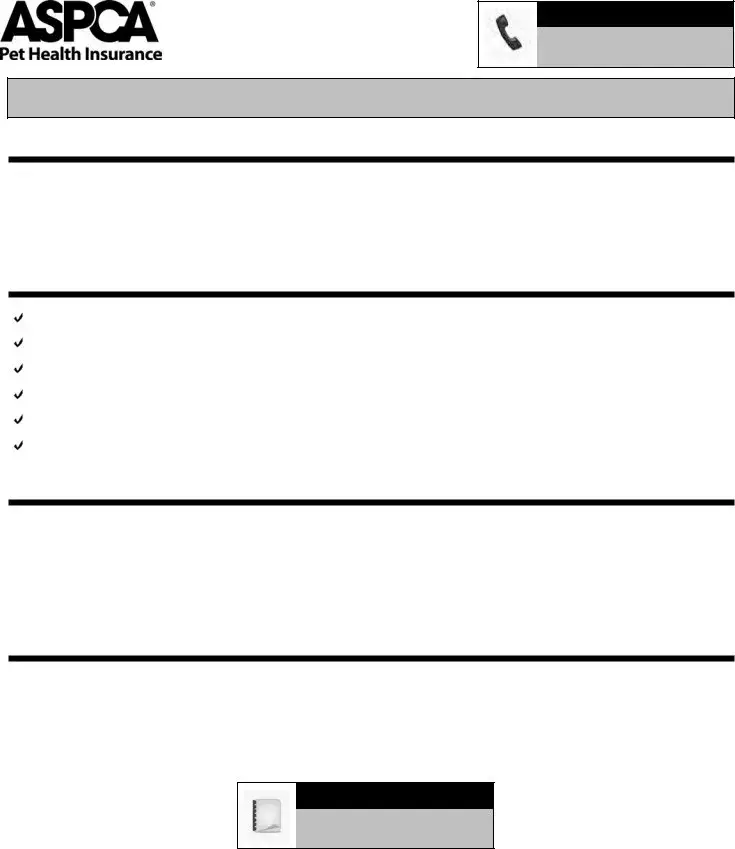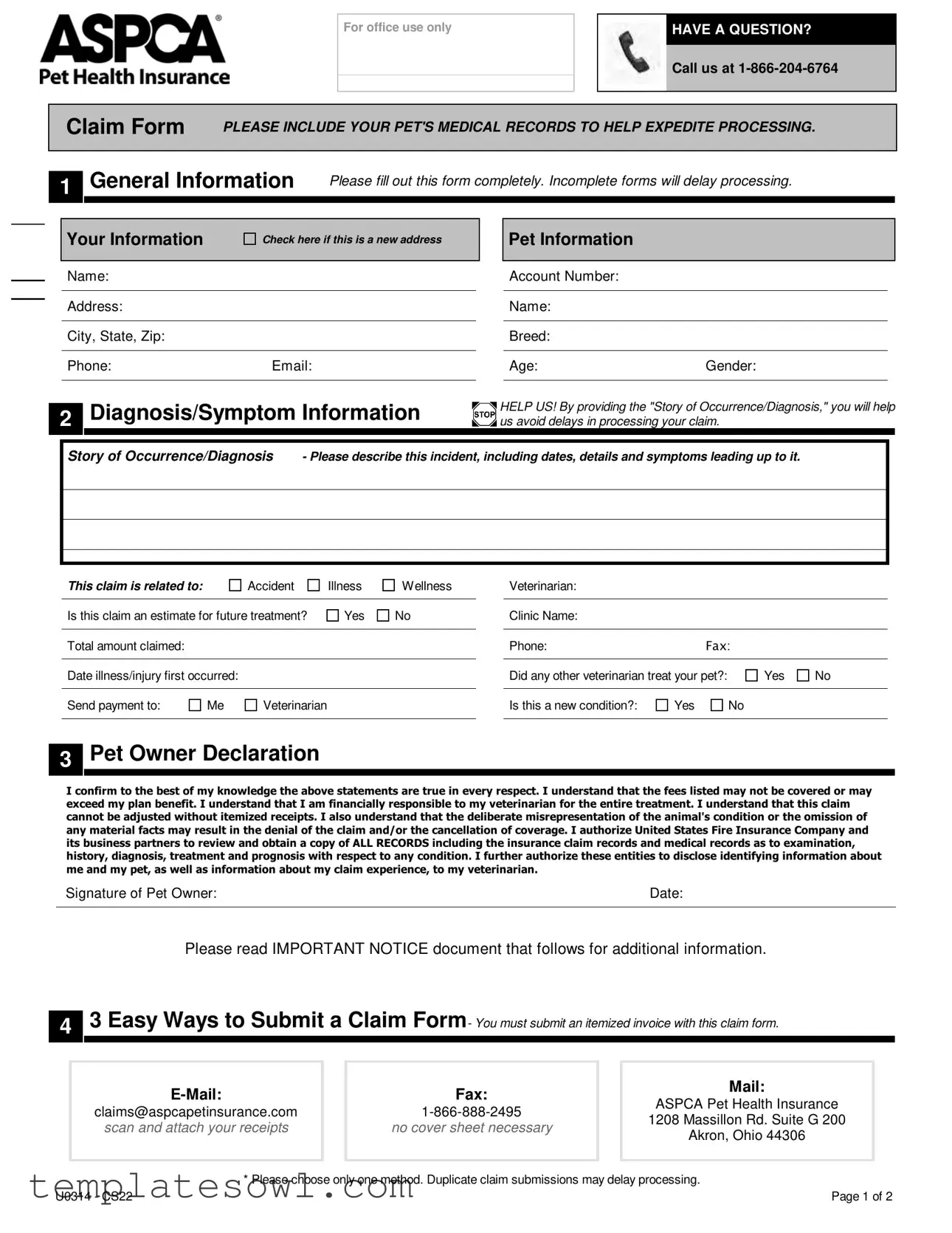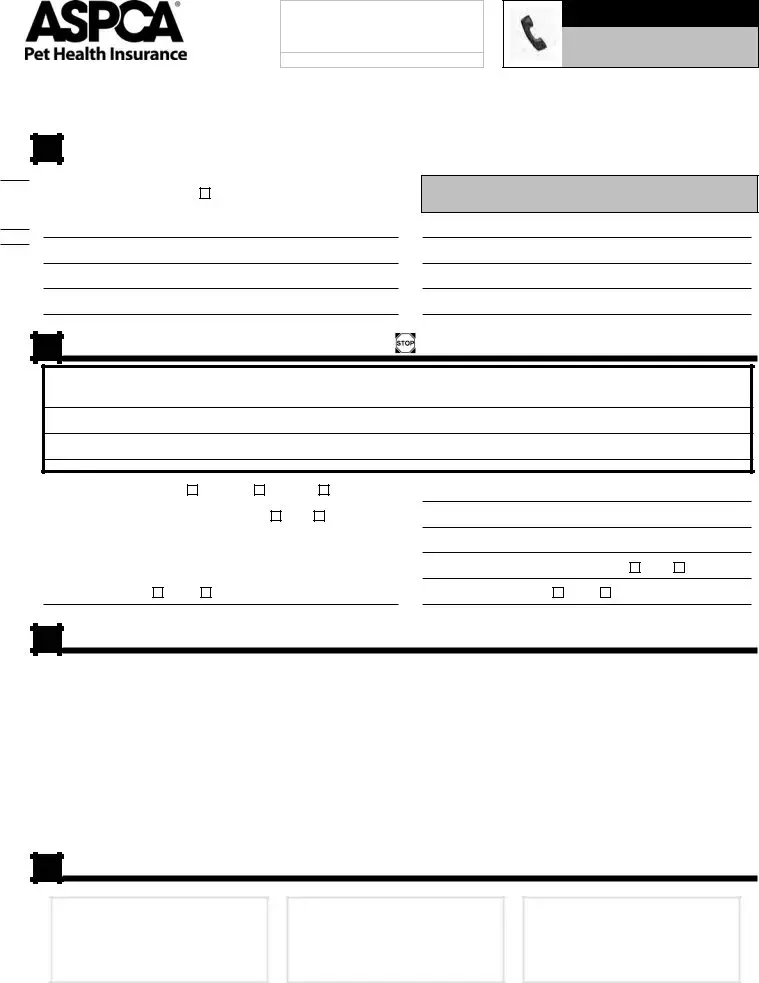HAVE A QUESTION?
Call us at 1-866-204-6764
Claim Form |
PLEASE INCLUDE YOUR PET'S MEDICAL RECORDS TO HELP EXPEDITE PROCESSING. |
|
|
General Information |
Please fill out this form completely. Incomplete forms will delay processing. |
|
|
|
|
Your Information |
Check here if this is a new address |
|
|
Name:
Address:
City, State, Zip:
Phone:Email:
Pet Information
Account Number:
Name:
Breed:
Age:Gender:
Diagnosis/Symptom Information
HELP US! By providing the "Story of Occurrence/Diagnosis," you will help us avoid delays in processing your claim.
Story of Occurrence/Diagnosis - Please describe this incident, including dates, details and symptoms leading up to it.
This claim is related to: |
Accident |
Illness |
W ellness |
|
|
|
Is this claim an estimate for future treatment? |
Yes |
No |
|
|
|
|
Total amount claimed: |
|
|
|
|
|
|
|
Veterinarian:
Clinic Name:
Phone:Fax:
Date illness/injury first occurred: |
Did any other veterinarian treat your pet?: |
|
|
Veterinarian |
Is this a new condition?: |
I confirm to the best of my knowledge the above statements are true in every respect. I understand that the fees listed may not be covered or may exceed my plan benefit. I understand that I am financially responsible to my veterinarian for the entire treatment. I understand that this claim cannot be adjusted without itemized receipts. I also understand that the deliberate misrepresentation of the animal's condition or the omission of any material facts may result in the denial of the claim and/or the cancellation of coverage. I authorize United States Fire Insurance Company and its business partners to review and obtain a copy of ALL RECORDS including the insurance claim records and medical records as to examination, history, diagnosis, treatment and prognosis with respect to any condition. I further authorize these entities to disclose identifying information about me and my pet, as well as information about my claim experience, to my veterinarian.
Signature of Pet Owner: |
Date: |
|
|
Please read IMPORTANT NOTICE document that follows for additional information.
3 Easy Ways to Submit a Claim Form- You must submit an itemized invoice with this claim form.
E-Mail:
claims@aspcapetinsurance.com
scan and attach your receipts
Fax:
1-866-888-2495
no cover sheet necessary
Mail:
ASPCA Pet Health Insurance
1208 Massillon Rd. Suite G 200
Akron, Ohio 44306
|
* Please choose only one method. Duplicate claim submissions may delay processing. |
U0314 - CS22 |
Page 1 of 2 |

HAVE A QUESTION?
Call us at 1-866-204-6764
Claim Form - You must submit an itemized invoice with this claim form.
How do I use my plan?
1.Visit any licensed veterinarian in the U.S. or Canada, including specialists and emergency clinics.
2.Pay the veterinarian directly for services.
3.Submit a claim form with itemized invoice for reimbursement.
It's easy to submit a claim! Here's a handy checklist:
Fill out this form completely and sign it. You don't need your veterinarian's signature.
Fax, mail or email your form with invoice(s) within 270 days of treatment.
If you use email, just scan and attach the form and invoice(s).
Include a copy of your pet's medical records to help expedite processing.
Please use only one claim form per pet for each accident or illness.
List your account number on all documents you send to us.
Track your claims and sign up for direct deposit.
You can check the status of your claims easily online by signing into our free Member Center at my.aspcapetinsurance.com. In the Member Center, you can also sign up for direct deposit of claim payments. It'll save time and a trip to the bank! Just click on "My Payments."
You'll also be able to view your plan and update your payment method when it's convenient for you.
Share your pet's story!
We'd love to hear how ASPCA Pet Health Insurance helped you and your pet. Send your story and a photo of your furry friend to us at my.aspcapetinsurance.com.
NEED MORE CLAIM FORMS?
Download forms at:
my.aspcapetinsurance.com
Plans are underwritten by the United States Fire Insurance Company and administered by Fairmont Specialty Insurance
Agency (FSIA Insurance Agency in CA), members of the Crum & Forster Enterprise.
IMPORTANT NOTICE
NOTICE TO CLAIMANTS: Any person who, with the intent to defraud or knowingly facilitates a fraud against an insurer, submits an application or files a claim containing a false or deceptive statement, or conceals information for the purpose of Misleading may be guilty of insurance fraud and subject to criminal and/or civil penalties.
NOTICE TO COLORADO CLAIMANTS: It is unlawful to knowingly provide false, incomplete, or misleading facts or information to an insurance company for the purpose of defrauding or attempting to defraud the company. Penalties may include imprisonment, fines, denial of insurance and civil damages. Any insurance company or agent of an insurance company who knowingly provides false, incomplete, or misleading facts or information to a policy holder or claimant for the purpose of defrauding or attempting to defraud the policy holder or claimant with regard to a settlement or award payable from insurance proceeds shall be reported to the Colorado Division of Insurance within the Department of Regulatory Agencies.
NOTICE TO CONNECTICUT APPLICANTS: Concealment, fraud. This entire policy shall be void if, whether before or after a loss, the insured has willfully concealed or misrepresented any material fact or circumstance concerning this insurance or the subject thereof, or the interest of the insured therein, or in case of any fraud or false swearing by the insured relating thereto.
NOTICE TO DISTRICT OF COLUMBIA CLAIMANTS: It is a crime to provide false or misleading information to an insurer for the purpose of defrauding the insurer or any other person. Penalties include imprisonment and/or fines. In addition, an insurer may deny insurance benefits if false information material related to a claim was provided by the applicant.
NOTICE TO FLORIDA CLAIMANTS: Any person who knowingly and with intent to injure, defraud, or deceive any insurer files a statement of claim or an application containing any false, incomplete, or misleading information is guilty of a felony of the third degree.
NOTICE TO HAWAII CLAIMANTS: For your protection, Hawaii law requires you to be informed that presenting a fraudulent claim for payment of a loss or benefit is a crime punishable by fines or imprisonment, or both.
NOTICE TO ILLINOIS CLAIMANTS: A person who knowingly makes a false or fraudulent statement or presentation in or with reference to any application for life insurance, or for the purpose of obtaining any fee, commission, money, or benefit from or in any company transacting business under this article, commits a Class A misdemeanor.
NOTICE TO KANSAS CLAIMANTS: fraudulent insurance act means an act committed by any person who, knowingly and with intent to defraud, presents, causes to be presented or prepares with knowledge or belief that it will be presented to or by an insurer, purported insurer, broker or any agent thereof, any written statement as a part of, or in support of, an application for the issuance of, or the rating of an insurance policy for personal insurance or commercial insurance, or a claim for payment or other benefit pursuant to an insurance policy for commercial or personal insurance which such person knows to contain materially false information concerning any fact material thereto; or conceals, for the purpose of misleading, information concerning any fact material thereto.
NOTICE TO KENTUCKY APPLICANTS: Any person who knowingly and with intent to defraud any insurance company or other person files an application for insurance containing any materially false information or conceals for the purpose of misleading, information concerning any fact material thereto commits a fraudulent insurance act which is a crime.
NOTICE TO LOUISIANA CLAIMANTS: Any person who knowingly presents a false or fraudulent claim for payment of a loss or benefit or knowingly presents false information in an application for insurance is guilty of a crime and may be subject to fines and confinement in prison.
NOTICE TO MAINE CLAIMANTS: It is a crime to knowingly provide false, incomplete or misleading information to an insurance company for the purpose of defrauding the company. Penalties may include imprisonment, fines or denial of insurance benefits.
NOTICE TO MARYLAND APPLICANTS: Any person who knowingly or willfully presents a false or fraudulent claim for payment of a loss or benefit or who knowingly or willfully presents false information in an application for insurance is guilty of a crime and may be subject to fines and confinement in prison.
IMPORTANT NOTICE
NOTICE TO NEW MEXICO CLAIMANTS: Any person who knowingly presents a false or fraudulent claim for payment of a loss or benefit or knowingly presents false information in an application for insurance is guilty of a crime and may be subject to civil fines and criminal penalties.
NOTICE TO NEW JERSEY CLAIMANTS: Any person who includes any false or misleading information on an application for an insurance policy is subject to criminal and civil penalties.
NOTICE TO NEW YORK APPLICANTS: Any person who knowingly and with intent to defraud an insurance company or other person files an application for insurance or statement of claim containing any materially false information, or conceals for the purpose of misleading, information concerning any fact material thereto, commits a fraudulent insurance act, which is a crime and shall be subject to a civil penalty not to exceed five thousand dollars and the stated value of the claim for each such violation.
NOTICE TO OHIO CLAIMANTS: Any person who, with intent to defraud or knowing that he is facilitating a fraud against an insurer, submits an application or files a claim containing a false or deceptive statement is guilty of insurance fraud.
NOTICE TO OKLAHOMA CLAIMANTS: WARNING: Any person who knowingly, and with intent to injure, defraud or deceive any insurer makes any claim for the proceeds of an insurance policy containing any false, incomplete or misleading information is guilty of a felony.
NOTICE TO PENNSYLVANIA CLAIMANTS: Any person who knowingly and with intent to defraud any insurance company or other person files an application for insurance or statement of claim containing any materially false information or conceals for the purpose of misleading, information concerning any fact material thereto commits a fraudulent insurance act, which is a crime and subjects such person to criminal and civil penalties.
NOTICE TO TENNESSEE CLAIMANTS: It is a crime to knowingly provide false, incomplete or misleading information to an insurance company for the purpose of defrauding the company. Penalties include imprisonment, fines or denial of insurance benefits.
NOTICE TO VIRGINIA CLAIMANTS: It is a crime to knowingly provide false, incomplete or misleading information to an insurance company for the purpose of defrauding the company. Penalties may include imprisonment, fines or denial of insurance benefits.
NOTICE TO WASHINGTON CLAIMANTS: It is a crime to knowingly provide false, incomplete, or misleading information to an insurance company for the purpose of defrauding the company. Penalties include imprisonment, fines, and denial of insurance benefits.




